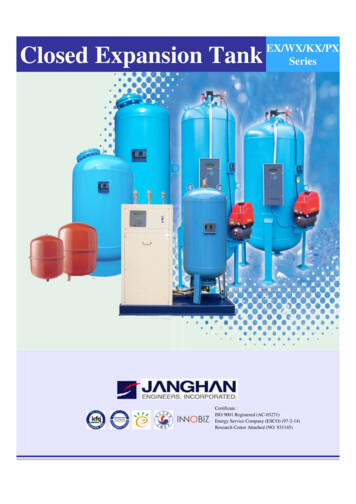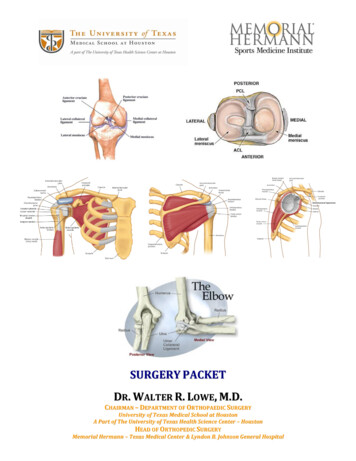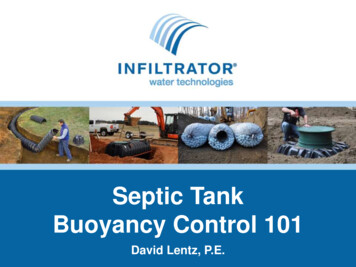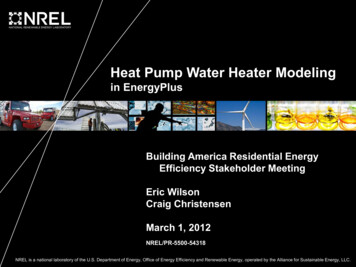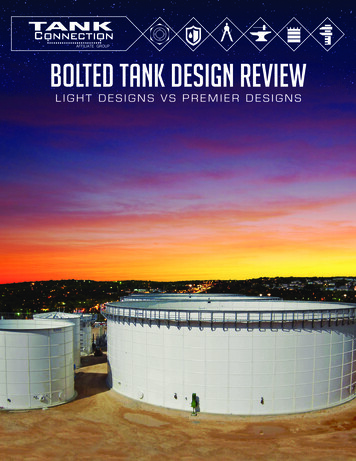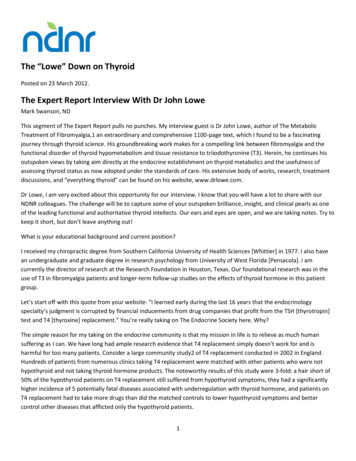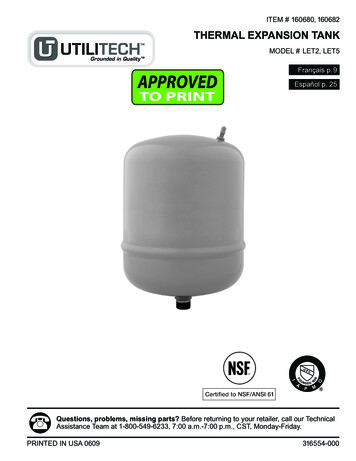
Transcription
ITEM # 160680, 160682THERMAL EXPANSION TANKMODEL # LET2, LET5Français p. 9Español p. 25Questions, problems, missing parts? Before returning to your retailer, call our TechnicalAssistance Team at 1-800-549-6233, 7:00 a.m.-7:00 p.m., CST, Monday-Friday.PRINTED IN USA 0609316554-0001
SAFE INSTALLATION USE AND SERVICEYour safety and the safety of others is extremely important in the installation, use and servicing ofthis expansion tank.Many safety- related messages and instructions have been provided in this manual and on your ownexpansion tank to warn you and others of a potential injury hazard. Read and obey all safety messagesand instructions throughout this manual. It is very important that the meaning of each safety messageis understood by you and others who install, use or service this expansion tank.All safety messages will generally tell you about the type of hazard, what can happen if you do notfollow the safety message and how to avoid the risk of injury.This is the safety alert symbol. It is used to alert you to potential personal injury hazards. Obeyall safety messages that follow this symbol to avoid possible injury or death.DANGER: indicates an imminently hazardous situation which, if not avoided, will result indeath or injury.WARNING: indicates a potentially hazardous situation which, if not avoided, could result indeath or injury.CAUTION: indicates a potentially hazardous situation which, if not avoided, could result inminor or moderate injury.All safety messages will generally tell you about the type of hazard, what can happen if you do notfollow the safety message and how to avoid the risk of injury.IMPORTANT DEFINITION: NSF (National Sanitation Foundation) - NSF International is ThePublic Health and Safety Company , providing public health and safety risk management solutionsto companies, governments and consumers around the world.IMPORTANT DEFINITION: A qualified installer must have ability equivalent to a licensed tradesmanin the field of plumbing and have a thorough understanding of the applicable local plumbing codes.GENERAL SAFETYWARNING: Explosion Hazard. Temperature-pressure relief valve must comply withANSI Z21.22 and ASME code. Overheated water can cause water tank explosion.Properly sized temperature and pressure relief valve must be installed in openingprovided. Failure to follow these instructions could result in death or serious injury.WARNING: Read and understand manual and safety messages beforeinstalling, operating or servicing this water heater. Failure to follow instructionsand safety messages could result in death or serious injury.2
CAUTION: Improper installation and use may be hazardous and can result in property damage.Improper installation and/or pressure settings will void warranty. Install in accordance with localcodes. Refer to manual for installation and service.DANGER: Burn hazard. Hot water discharge. Keep clear of relief valve discharge outlet.TABLE OF CONTENTSSAFE INSTALLATION USE AND SERVICE. 2GENERAL SAFETY. 2TABLE OF CONTENTS. 3SPECIFICATIONS. 3IMPORTANT INSTRUCTIONS BEFORE INSTALLATION. 4LOCATING THE NEW EXPANSION TANK. 5INSTALLING THE EXPANSION TANK. 6-7MAINTENANCE. 7WARRANTY. 8SPECIFICATIONSEXPANSION TANKS FOR WATER HEATERSMany local codes require back flow preventers, check valves or non-reversing meters. Since thesedevices seal off the system, an expansion tank is required to prevent the water heater’s relief valve fromdischarging on every heating cycle. The LET series expansion tanks eliminate this wasteful, costly, anddangerous practice. The LET tanks are designed to be used for potable water storage at a maximumpressure of 150 psi. DO NOT USE A STANDARD TANK. Use the sizing chart to determine the correctsize expansion tank for your application.PURPOSE OF EXPANSION TANKSWhen water is heated it expands. Provision must be made for this expansion in a closed hot watersystem. This precharged diaphragm tank stores the expanded hot water then returns water to the systemwhen the temperature drops.COLD WATERTO PRELIEFVALVE
TANK SPECIFICATIONSTANK MODELLET2LET5CAPACITY IN GALLONS25PRECHARGE PRESURE IN PSI2525DIMENSIONS “A”12 in.14 in.DIMENSIONS “C”8 1/4 in.11 1/4 in.DISCHARGE CONNECTION “E”3/4 in. NPTM3/4 in. NPTMWEIGHT6 LBS.10.5 LBS.EXPANSION TANK SIZING CHARTAssumed 140 Temp and 150 PSI Max. PressureEXPANSION TANK NEEDEDWATER HEATER CAPACITY (GALLONS)INCOMING WATERPRESSURE304050668010012040 psi2 GAL2 GAL2 GAL5 GAL5 GAL5 GAL5 GAL50 psi2 GAL2 GAL2 GAL5 GAL5 GAL5 GAL5 GAL60 psi2 GAL2 GAL5 GAL5 GAL5 GAL5 GAL5 GAL70 psi80 psi2 GAL2 GAL2 GAL5 GAL5 GAL5 GAL5 GAL5 GAL5 GAL5 GAL5 GAL5 GAL5 GAL5 GALIMPORTANT INSTRUCTIONS BEFORE INSTALLATION1. Be sure installation meets all local plumbing codes.2. If you are not thoroughly familiar with plumbing and safety practices, consult your local store forfurther information.3. Check the water heater temperature-pressure relief valve for proper operation; replace if found tobe faulty.WARNING: Explosion Hazard. Temperature-pressure relief valve must comply withANSI Z21.22 and ASME code. Overheated water can cause water tank explosion.Properly sized temperature and pressure relief valve must be installed in openingprovided. Failure to follow these instructions could result in death or serious injury.When checking the temperature-pressure relief valve operation, make sure that (1) no one is infront of or around the outlet of the temperature-pressure relief valve discharge line, and (2) thewater manually discharged will not cause any property damage or bodily injury. The water maybe extremely hot.If the valve fails to completely reset and continues to release water after manual operation,immediately close the cold water inlet to the water heater, follow draining instructions, and replacethe temperature-pressure relief valve with a new one.Also read and follow additional information found in the water heater manual concerning thetemperature-pressure relief valve.4
4. Read this owner’s manual and the installation rules carefully. If you do not follow the safety rules,the expansion tank will not operate properly. It could cause DEATH, SERIOUS BODILY INJURYAND/OR PROPERTY DAMAGE.5. If incoming water pressure to the home exceeds 80 psi, a pressure reducing valve will be required.Recommended inlet water pressure is 60 psi or less.6. In order to determine incoming water pressure and for proper adjustment of the pressurereducing valve, a pressure gauge must be installed between the pressure reducing valve andexpansion tank.7. The complete piping system, including expansion tank and pressure reducing valve, MUSTbe protected against below freezing temperatures. Failure to do so could cause severewater damage.8. To safeguard against a possible dangerous malfunction of the expansion tank, review theinstallation instructions before putting the water supply system back into operation.This hydro-pneumatic tank is designed and intended for hot or cold water storage at a maximumpressure of 150 pounds per square inch gauge (150 PSIG). Any use other than with potable wateror at a sustained or instantaneous pressure in excess of 150 psi is UNSAFE. A pressure reliefvalve of adequate size must be incorporated in the water heater system. This expansion tank,as all tanks, will eventually leak.Do not install without adequate drainage provisions where waterleakage will cause damage. Failure to follow these instructions can cause an explosion and resultin SERIOUS OR FATAL INJURY.CAUTION: Improper installation and use may be hazardous and can result in property damage.Improper installation and/or pressure settings will void warranty. Install in accordance with localcodes. Refer to manual for installation and service.LOCATING THE NEW EXPANSION TANKFACTS TO CONSIDER ABOUT THE LOCATION1. The location selected should be indoors in an area not subject to freezing.2. The items which should be installed in the cold water line, in sequence from the water heater,are (1) the EXPANSION TANK (2) a PRESSURE GAUGE and (3) a PRESSURE REDUCINGVALVE, if required. See Figure 1.WATER HEATERCOLD WATER K(3)PRESSUREREDUCINGVALVE WITHBY-PASSINLETCOLD WATERSHUT-OFFRECOMMENDED INSTALLATION - VERTICAL MOUNTINGFIGURE 1.5
3. The expansion tank is designed to be supported by the system piping in the vertical position.If, however, the expansion tank must be installed horizontally, as shown in Figure 2, it must besupported by adequate strapping (not supplied).4. The expansion tank, pipes, and your connections may, in time, leak. Put the expansion tank ina place where a water leak will not damage anything. The expansion tank should be located inan area where water leakage from the tank or connections will not result in damage to the areaaround the expansion tank or to the lower floors of the structure.WATER HEATERCOLD WATER INLETFITTINGHOTCOLD(1)EXPANSIONTANKFLOOR, CEILING,JOINT, ETC.STRAPPING(3)PRESSUREREDUCINGVALVE WITHBY-PASS(2)PRESSUREGUAGEINLETCOLD WATERSHUT-OFFRECOMMENDED INSTALLATION - VERTICAL MOUNTINGFIGURE 2.INSTALLING THE EXPANSION TANKWATER PIPINGThis expansion tank is designed for operation on the inlet cold water line and is limited to amaximum working pressure of 150 pounds per square inch (psi).Figures 1 and 2 above show the correct valves and fittings that you will need to install yourexpansion tank. A threaded (3/4 in.) water connection is supplied on the tank bottom.FOLLOW THE INSTALLATION INSTRUCTIONS FOUND IN THE PACKAGING OF THE PRESSUREREDUCING VALVE AND PRESSURE GAUGE.1. The water supply and power (electricity or gas) must be shut off during the installation ofthe valves and expansion tank. Follow the instructions found on the water heater and in theowner’s manual.2. Install expansion tank, pressure gauge, and pressure reducing valve, if required, as shownabove in Figures 1 and 2.3. After installing the expansion tank, pressure gauge, and pressure reducing valve, it will benecessary to expel all air from the piping. Turn the cold water inlet shut-off valve “ON.” To purgethe air, open a faucet and wait until a steady stream of water is coming from the faucet. At thistime, close the faucet.ADJUSTING WATER PRESSURE1. Recommended inlet water pressure is 60 psi or less.2. Refer to the pressure gauge. Using the adjusting screw on the pressure reducing valve, increaseor decrease the pressure as indicated on the valve.6
3. Open a nearby faucet allowing water to run briefly and then close the faucet. Check pressuregauge again and make additional screw adjustments as necessary. It may be necessary torepeat this procedure several times before the pressure can be adjusted to 60 psi or less.CHECKING EXPANSION TANK AIR CHARGE1. Shut off main cold water supply valve.2. Open a nearby faucet allowing water to run until it stops. This indicates pressure has been relieved.3. Using a tire gauge, check the expansion tank’s pre-charge pressure (25 psi). The expansiontank air charge must be adjusted to match the incoming water pressure. If the air charge pressureneeds to be adjusted upward, use only a manual type tire pump to increase the pressure. If theair charge needs to be reduced, depress the valve core to release pressure.4. Open the cold water supply valve.5. Now the water heater can be put back into operation. Follow instructions found on the waterheater and in the manual.MAINTENANCEWATER HEATER TEMPERATURE-PRESSURE RELIEF VALVEThe temperature-pressure relief valve on the water heater must be manually operated at least once a year.DANGER: Burn hazard. Hot water discharge. Keep clear of relief valve discharge outlet.TEMPERATURE-PRESSURERELIEF VALVEDISCHARGE PIPEWhen checking the temperature-pressure relief valve operation, make sure that (1) no one is infront of or around the outlet of the temperature-pressure relief valve discharge line, and (2) thewater manually discharged will not cause any property damage or bodily injury. The water maybe extremely hot.If the valve fails to completely reset and continues to release water after manual operation,immediately close the cold water inlet to the water heater, follow draining instructions, and replacethe temperature relief valve with a new one.WEEPING TEMPERATURE-PRESSURE RELIEF VALVEIf the temperature-pressure relief valve on the water heater weeps or discharges periodically, thismay be due to one or more of the following:1. The temperature-pressure relief valve may have become faulty. Refer to your water heatermanual for more information.2. The inlet water pressure may be above the recommended 60 psi. Follow the instructions in the“Adjusting Water Pressure” section.3. The expansion tank’s air charge pressure may not be adjusted to match the incoming waterpressure. Follow the instructions in the “checking Expansion Tank Air Charge” section.4. If all of the above have been checked, adjusted and/or replaced, turn water heater “OFF” andcontact the local utility.7
WARRANTYONE YEAR LIMITED WARRANTY ON LET SERIES THERMAL EXPANSION TANKThe Company warrants this expansion tank in case of a leak within one (1) year from the date of purchase orin the absence of a Bill of Sale verifying said date, from the date indicated on the model and rating plate affixedto this tank. In case of a defect, malfunction, or failure to conform to this warranty, the Company will repair orreplace this tank. No labor, installation, or freight (if any) charges are included in this warranty. You must paythese costs.Prior to return of the expansion tank or part to the manufacturer for inspection, the Company will, if requested,ship a replacement expansion tank or part C.O.D. and later provide such reimbursement as subsequentinspection indicates is due under these warranties.EXCLUSIONS AND LIMITATIONS OF THESE LIMITED WARRANTIES1. The limited warranties provided herein are in lieu of any and all warranties, expressed or implied,including, but not limited to, implied warranties of merchantability and fitness for a particular purpose; provided,however, that implied warranties are not disclaimed during the one-year period from date of purchase. Some statesdo not allow limitations on how long an implied warranty lasts, so the above limitation may not apply to you.2. The company shall have no liability hereunder, either direct or contingent, for incidental or consequential damages.Some states do not allow the exclusion or limitation of incidental or subsequential damages, so the above limitationor exclusion may not apply to you.3. This warranty gives you specific legal rights, and you may also have other rights which vary from state to state.4. These warranties shall be void and shall have no effect:a. If the design or structure of the tank is, or is attempted to be, modified or altered in any way, including, but notlimited to, attaching non-Company approved appliances or equipment.b. If the tank is not properly installed in accordance with all local ordinances and regulations pertinent to tanks andthe installation and instruction manual provided with this tank.c. If the expansion tank is installed outdoors. This tank is intended for indoor installation only.d. If leaks in the tank, or defects in other parts, arise as the result of improper use, negligence in operation, accident,or from inability of the tank or any of its parts to function because of repairs, adjustments, or replacementsimproperly made outside the Company’s factory, or because of fire, floods or lightning.e. If the model and rating plate has been defaced or discarded and you do not have a Bill of Sale to verify thepurchase date.f. If the tank is used for any purpose other than in a potable water system.g. If the tank is used with pools, whirlpools, or hot tubs, or with any equipment or system that uses heavily chlorinatedor otherwise nonpotable water.h. If leaks in the tank or defects in other parts occur as a result of the tank being exposed to a highly corrosiveatmospheric condition.i. If leaks in the tank or defects in other parts occur as a result of the tank containing and/or being operated with desalinated(de ionized) water.j. If leaks in the tank or defects in other parts arise as a result of sizing that does not comply with the manufacturer’scurrently published sizing guides or sizing recommended by the manufacturer.k. If this expansion tank or any part has been under water.5. Replacements and/or repairs furnished under these warranties do not carry a new warranty, only the unexpiredportion of the original warranty.6. The terms of this warranty may not be varied by any person, whether or not purporting to represent or to act onbehalf of the Company.7. In order to obtain service under these warranties you must promptly notify the installing contractor or dealer, givingthe nature of the problem and the model and serial number of the tank. If for any reason the installer or dealer cannotbe located or fails to provide satisfactory warranty service, you should write the Company with the above information.For Technical Assistance or Service Information you should write to A. O. Smith, 500 Tennessee Waltz Parkway,Ashland City, TN 37015.8
ARTICLE NO 160680, 160682RÉSERVOIR DE DILATATIONTHERMIQUEMODÈLE NO LET2, LET5English p. 1Español p. 17Des questions, des problèmes, des pièces manquantes? Avant de rapporter le produità votre détaillant, appelez notre équipe d’assistance technique au 1 800 549-6233, entre 7 het 19 h (HNC), du lundi au vendredi.IMPRIMÉ AUX ÉTATS-UNIS 0609316554-0009
INSTALLATION, UTILISATION ET ENTRETIEN SÉCURITAIRESVotre sécurité et celle des autres est extrêmement importante pendant l’installation, l’utilisation et l’entretiende ce réservoir de dilatation.Plusieurs consignes et messages liés à la sécurité ont été inclus dans ce guide et placés sur votre réservoirde dilatation pour vous prévenir, ainsi que ceux qui vous entourent, des risques de blessures possibles.Veuillez lire et respecter toutes les consignes de sécurité et tous les messages qui se trouvent dans ce guide.Il est très important que vous et chaque personne devant faire l’installation ou l’entretien de ce réservoir dedilatation ou qui doit l’utiliser compreniez bien chacune des consignes qui s’y rapportent.Toutes les consignes de sécurité fournissent habituellement des renseignements sur le type de risque, ce quipeut se produire si vous ne respectez pas la consigne de sécurité et la façon d’éviter le risque de blessure. Voici un pictogramme d’alerte de sécurité. Il sert à vous indiquer les risques potentiels de blessures.Respectez toutes les consignes de sécurité associées à ce pictogramme pour éviter les risques deblessures ou de mort. DANGER : Indique un risque imminent qui entraînera la mort ou des blessures sérieuses s’il n’estpas évité. AVERTISSEMENT : Indique un risque potentiel pouvant entraîner la mort ou des blessuressérieuses s’il n’est pas évité. MISE EN GARDE : Indique un risque potentiel pouvant entraîner des blessures mineures s’il n’estpas évité.Toutes les consignes de sécurité fournissent habituellement des renseignements sur le type de risque,ce qui peut se produire si vous ne respectez pas la consigne de sécurité et la façon d’éviter le risquede blessure. ÉFINITION IMPORTANTE : NSF (National Sanitation Foundation) — La NSF International, The PublicDHealth and Safety CompanyMC, est une société qui offre des services dans le domaine de la santé etde la sécurité publique ainsi que des solutions de gestion du risque en matière de santé et de sécuritéà des entreprises, des gouvernements et des consommateurs partout dans le monde. DÉFINITION IMPORTANTE : Un installateur qualifié doit posséder des compétences équivalentesà celle d’un ouvrier qualifié dans le domaine de la plomberie et des connaissances approfondies ducode de plomberie local en vigueur.CONSIGNES DE SÉCURITÉ GÉNÉRALES AVERTISSEMENT : Risque d’explosion. La soupape de décharge de pression etde température doit être conforme à la norme ANSI Z21.22 et au code ASME. De l’eausurchauffée peut causer l’explosion du réservoir d’eau. Une soupape de déchargede pression et de température de dimensions appropriées doit être installée dansl’ouverture fournie. Le non-respect de ces instructions peut entraîner des blessuresgraves ou la mort. AVERTISSEMENT : Assurez-vous de lire et de comprendre ce guide et lesconsignes de sécurité avant de procéder à l’installation, à la mise en marche ou àl’entretien de ce chauffe-eau. Le non-respect des instructions et des consignes desécurité peut entraîner des blessures graves ou la mort.10
MISE EN GARDE : Une installation et une utilisation inadéquates peuvent être dangereuses etpourraient causer des dommages matériels. Une installation inadéquate et des réglages de pressionincorrects annuleront la garantie. Installez conformément au code local en vigueur. Reportez-vous auguide pour l’installation et l’entretien. DANGER : Risque de brûlure. Déversement d’eau chaude. Évitez de vous placer à proximité dela sortie de la soupape de décharge.TABLE DES MATIÈRESINSTALLATION, UTILISATION ET ENTRETIEN SÉCURITAIRES. 2CONSIGNES DE SÉCURITÉ GÉNÉRALES. 2TABLE DES MATIÈRES. 3CARACTÉRISTIQUES. 3DIRECTIVES IMPORTANTES À LIRE AVANT DE COMMENCER L’INSTALLATION. 4EMPLACEMENT DU NOUVEAU RÉSERVOIR DE DILATATION. 5INSTALLATION DU RÉSERVOIR DE DILATATION. 6-7ENTRETIEN. 7GARANTIE. 8CARACTÉRISTIQUESRÉSERVOIR DE DILATATION POUR CHAUFFE-EAUDe nombreux codes locaux exigent des clapets de non-retour, des soupapes, des détendeurs ou des mètresnon inverseurs. Puisque ces dispositifs rendent le système étanche, un réservoir de dilatation est nécessairepour empêcher la soupape de décharge du chauffe-eau de refouler de l’eau à chaque cycle de chauffage.La série de réservoir de dilatation LET élimine ce gaspillage coûteux et dangereux. Les réservoirs LETsont conçus pour stocker de l’eau potable à une pression maximale de 150 lb/po2. N’UTILISEZ PAS UNRÉSERVOIR STANDARD. Reportez-vous au tableau de dimensions afin de choisir le réservoir de dilatationapproprié pour votre installation.UTILITÉ D’UN RÉSERVOIR DE DILATATIONQuand l’eau est chauffée, elle se dilate. Cette dilatation doit être prévue dans un système d’eau chaude encircuit fermé. Ce réservoir préchargé à membrane stocke l’eau chaude dilatée, puis la réachemine dans lesystème lorsque la température baisse.EAU FROIDEVERS LE SYSTÈMECHAUFFEEAURÉSERVOIRDEDILATATIONCLAPET DENON-RETOUR11SOUPAPE DEDÉCHARGE(PRESSION ETTEMPÉRATURE)
CARACTÉRISTIQUES DU RÉSERVOIRN DE MODÈLE DU RÉSERVOIRLET2LET5CAPACITÉ EN GALLONS25PRESSION PRÉCHARGÉE EN LB/PO22525DIMENSIONS « A »12 po14 poDIMENSIONS « C »8 1/4 po11 1/4 poRACCORD DE DÉCHARGE « E »3/4 po NPTM3/4 po NPTMPOIDS6 LB10,5 LBTABLEAU DE DIMENSIONS DU RÉSERVOIR DE DILATATIONTempérature prévue de 140 F; pression maximale de 150 lb/po2RÉSERVOIR DE DILATATION APPROPRIÉCAPACITÉ DU CHAUFFE-EAU (GALLONS)PRESSION DEL’ALIMENTATION EN EAU304050668010012040 lb/po22 GAL2 GAL2 GAL5 GAL5 GAL5 GAL5 GAL50 lb/po22 GAL2 GAL2 GAL5 GAL5 GAL5 GAL5 GAL60 lb/po22 GAL2 GAL5 GAL5 GAL5 GAL5 GAL5 GAL70 lb/po280 lb/po22 GAL2 GAL2 GAL5 GAL5 GAL5 GAL5 GAL5 GAL5 GAL5 GAL5 GAL5 GAL5 GAL5 GALDIRECTIVES IMPORTANTES À LIRE AVANT DE COMMENCER L’INSTALLATION1. Assurez-vous que l’installation est conforme au code de plomberie local.2. Si vous n’êtes pas certain de bien comprendre les pratiques de plomberie et de sécurité, adressez-vousà votre détaillant local pour obtenir de plus amples renseignements.3. Vérifiez la soupape de décharge de pression et de température du chauffe-eau pour vous assurer qu’ellefonctionne adéquatement; remplacez-la si elle est défectueuse.AVERTISSEMENT : Risque d’explosion. La soupape de décharge de pression et de température doit être conforme à la norme ANSI Z21.22 et au code ASME. De l’eausurchauffée peut causer l’explosion du réservoir d’eau. Une soupape de déchargede pression et de température de dimensions appropriées doit être installée dansl’ouverture fournie. Le non-respect de ces instructions peut entraîner des blessuresgraves ou la mort.Lorsque vous vérifiez le fonctionnement de la soupape de décharge de pression et de température,assurez-vous que (1) personne ne se trouve devant ou près de la sortie de la soupape de décharge;et que (2) l’eau évacuée manuellement n’entraînera pas de dommages matériels ou de dommagescorporels. L’eau pourrait être extrêmement chaude.Si la soupape ne se remet pas à l’état initial et continue à déverser de l’eau à la suite de cette manœuvre,fermez immédiatement l’alimentation en eau froide du chauffe-eau, suivez les instructions de drainageet remplacez la soupape de décharge de pression et de température.Veuillez également lire et suivre les instructions supplémentaires dans le guide d’utilisation du chauffeeau concernant la soupape de décharge de pression et de température.12
4. Lisez attentivement le guide d’utilisation et les instructions d’installation. Si vous ne suivez pas lesconsignes de sécurité, le réservoir de dilatation ne fonctionnera pas correctement. Cela pourrait entraînerLA MORT, DES DOMMAGES CORPORELS ET/OU DES DOMMAGES MATÉRIELS GRAVES.5. Si la pression de l’eau qui alimente la maison excède 80 lb/po2, un détendeur de pression sera nécessaire.Une pression de l’alimentation en eau de 60 lb/po2 ou moins est recommandée.6. Afin de déterminer la pression de l’alimentation en eau et de régler correctement le détendeur de pression,un manomètre doit être installé entre le détendeur de pression et le réservoir de dilatation.7. L’ensemble du système de tuyauterie, y compris le réservoir de dilatation et le détendeur de pression,DOIT être protégé contre les températures situées au-dessous du point de congélation. Sinon, celapourrait entraîner de graves dégâts d’eau.8. P our prévenir tout grave dysfonctionnement possible du réservoir de dilatation, consultez lesinstructions d’installation avant de remettre le système d’alimentation en eau en marche.Ce réservoir hydropneumatique est conçu pour le stockage d’eau chaude ou froide à une pressionmaximale de 150 lb/po2. Toute utilisation autre qu’avec de l’eau potable ou à une pression soutenueou instantanée de plus de 150 lb/po2 n’est PAS SÉCURITAIRE. Il convient d’incorporer au systèmedu chauffe-eau une soupape de décharge de dimension appropriée. Ce réservoir de dilatation, commetous les réservoirs, finira par subir des fuites. Ne l’installez pas sans avoir prévu un drainage adéquatlà où une fuite d’eau pourrait causer des dommages. Le non-respect de ces instructions pourraitprovoquer une explosion et causer DES BLESSURES GRAVES OU MORTELLES.MISE EN GARDE : Une installation et une utilisation inadéquates peuvent être dangereuses et pourraient causer des dommages matériels. Une installation inadéquate et des réglages de pressionincorrects annuleront la garantie. Installez conformément au code local en vigueur. Reportez-vous auguide pour l’installation et l’entretien.EMPLACEMENT DU NOUVEAU RÉSERVOIR DE DILATATIONPOINTS À CONSIDÉRER RELATIVEMENT À L’EMPLACEMENT1. L’emplacement choisi doit être à l’intérieur dans un endroit qui n’est pas soumis à des températuresinférieures au point de congélation.2. Voici les articles qui doivent être installés sur l’entrée de l’eau froide, en ordre séquentiel à partirdu chauffe-eau : (1) le RÉSERVOIR DE DILATATION; (2) un MANOMÈTRE; et (3) un DÉTENDEURDE PRESSION, au besoin. Voir la figure 1.RACCORDD’ALIMENTATIONEN EAU FROIDE RDEDILATATION(3) DÉTENDEURDE PRESSIONAVECRACCORD DEDÉRIVATIONDISPOSITIF D’ARRÊTDE L’ALIMENTATIONEN EAU FROIDEINSTALLATION RECOMMANDÉE — MONTAGE À LA VERTICALEFIGURE 1.13
3. Le réservoir de dilatation est conçu pour être retenu par un système de tuyauterie en positionverticale. Si, toutefois, le réservoir de dilatation doit être installé à l’horizontale, comme l’illustre lafigure 2, il doit être retenu par des attaches appropriées (non fournies).4. Avec le temps, le réservoir de dilatation, les tuyaux et les connexions pourraient fuir. Placez le réservoirde dilatation dans un endroit où une fuite d’eau ne pourrait endommager quoi que ce soit. Le réservoir dedilatation doit être placé dans un endroit où une
The LET tanks are designed to be used for potable water storage at a maximum pressure of 150 psi. DO NOT USE A STANDARD TANK. Use the sizing chart to determine the correct size expansion tank for your application. PURPOSE OF EXPANSION TANKS When water is heated it expands. Provision must be made for this expansion in a closed hot water system.

